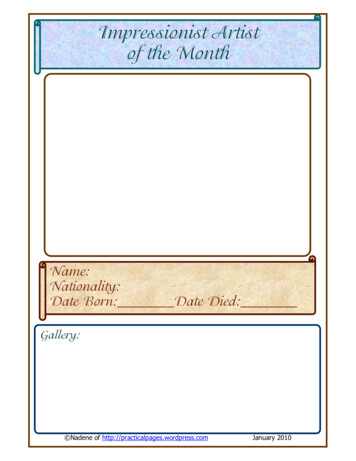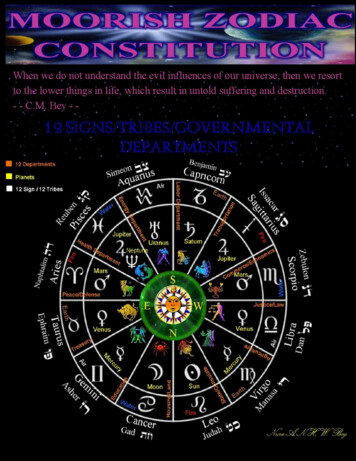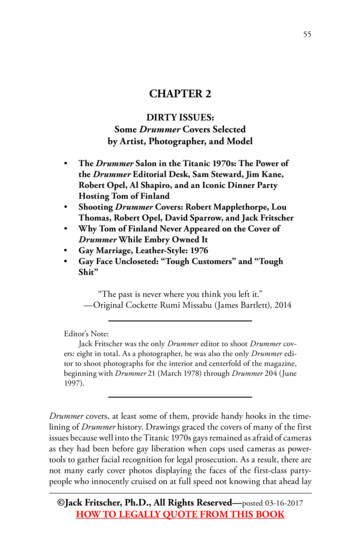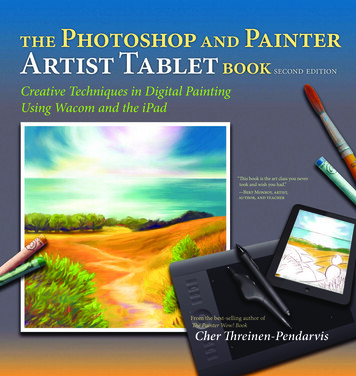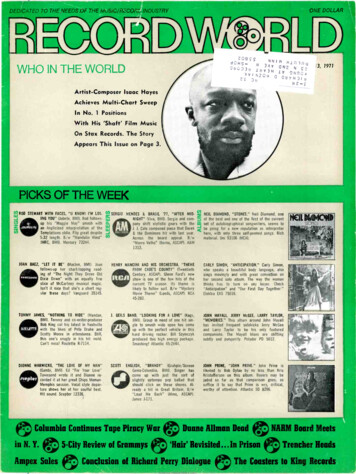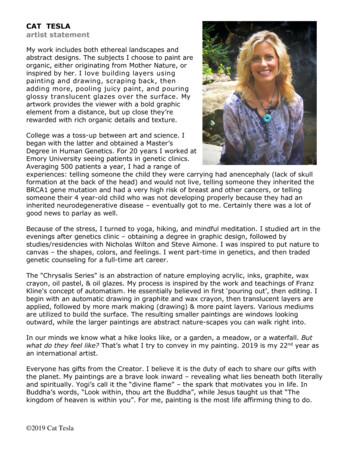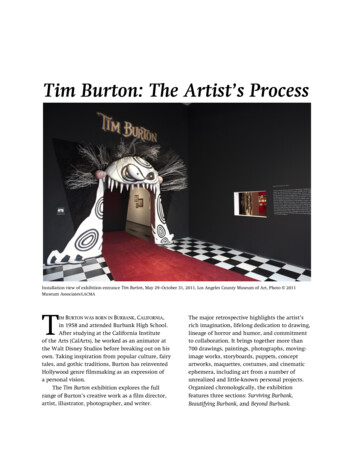
Transcription
Tim Burton: The Artist’s ProcessInstallation view of exhibition entrance Tim Burton, May 29–October 31, 2011, Los Angeles County Museum of Art, Photo 2011Museum Associates/LACMATIM BURTON WAS BORN IN BURBANK, CALIFORNIA,in 1958 and attended Burbank High School.After studying at the California Instituteof the Arts (CalArts), he worked as an animator atthe Walt Disney Studios before breaking out on hisown. Taking inspiration from popular culture, fairytales, and gothic traditions, Burton has reinventedHollywood genre filmmaking as an expression ofa personal vision.The Tim Burton exhibition explores the fullrange of Burton’s creative work as a film director,artist, illustrator, photographer, and writer.The major retrospective highlights the artist’srich imagination, lifelong dedication to drawing,lineage of horror and humor, and commitmentto collaboration. It brings together more than700 drawings, paintings, photographs, movingimage works, storyboards, puppets, conceptartworks, maquettes, costumes, and cinematicephemera, including art from a number ofunrealized and little-known personal projects.Organized chronologically, the exhibitionfeatures three sections: Surviving Burbank,Beautifying Burbank, and Beyond Burbank.
While only a portion of the works on view can befeatured in this curriculum, these materials highlight key concepts in the artist’s body of work aswell as address the larger implications of what itmeans to be an artist today. In what ways is Burton’s process similar to ordifferent from other contemporary artists?How does Burton use sketching as a tool tocultivate creativity? How does sketchingtranslate into other disciplines? How can weintegrate this idea of process into our ownclassroom practices? And, how can we, likeBurton, work collaboratively to produceimaginative work?(“When I was growing up in Burbank, theenvironment was very middle-class suburban,And I felt like an alien,” says Tim Burton.1 Hesurvived this feeling of alienation on the strengthof his imagination. He consoled himself with thepleasures of drawing and humor and an interestin visual media that he indulged through colorfulforms of popular entertainment: newspaper comics,advertising, greeting cards, children’s literature,toys, animated cartoons, monster movies, sciencefiction films, carnival sideshows, performanceart, and holiday rituals, including the art of theMexican Day of the Dead. Burton was heavilyinfluenced by popular culture and has used hischildhood in Burbank as a resource for the subjectsand themes that he has explored in feature films,shorts, and commercials since 1982.From childhood to the present, Burton hasexpressed himself through drawing. At a youngage, he had a teacher who didn’t force him todraw a certain way, but rather encouraged studentsto draw in their own style and approach drawingas a means to explore their fantasy life andemotional core. Burton says, “I was not a veryverbal communicator growing up, so it was a formof communication for me.”2 For Burton, sketchingis an activity concurrent with seeing and thinking—the conduit of imagination and an importantpart of his thought process. His notes and sketchesare a way to think through ideas or projects. How is sketching similar to the writingprocess of drafting and editing? How canwe encourage our students to use the toolsof artists—sketching, revising, editing—asa means to think through concepts, developand refine ideas?Burton’s talent matured during two years ofstudy at the California Institute of the Arts(CalArts) and four years working as an animatorat the Walt Disney Company. A number of hissignature motifs and stylistic traits emergedduring this period, such as his creature-basedcharacters, his use of masks and body modification, and his exploration of the relationshipbetween childhood and adulthood.Many of Burton’s recurring themes stemfrom childhood and adolescence and combinea unique mix of horror and humor. The vastmajority of the hundreds of artworks in theexhibition are drawings, from sketches anddoodles to cartoons and character studies. Evenin the earliest of these, Burton’s key themes andstorylines are evident: creatures transformingfrom one thing into another, quirky childrenattempting to make sense of equally odd adults,skeletons mingling with humans.Many of the great printmakers in art historyhave also explored these same motifs. Longbefore film emerged as the leading mass-culturemedium, printmaking was a primary and democratic means of disseminating ideas widely.Burton’s emphasis on exaggeration, distortion,and fantasy parallel the work of many artiststhroughout history, particularly that of theGerman Expressionists. View the enclosed CD to see an idiosyncraticarray of graphic works chosen by Tim Burtonin consultation with the museum’s curatorialstaff. Compare and contrast these with worksby Burton and with his completed films.
Burton’s career blossomed through his workin feature films. Pee-wee’s Big Adventure (1985),Beetlejuice (1988), Batman (1989), and EdwardScissorhands (1990) made him a brand namebefore his sixth feature, Tim Burton’s TheNightmare Before Christmas (1993), was released.In this phase of his creative life, rewardingprofessional collaborations helped bring hispersonal vision to the screen. Burton oftenworks with the same creative team. Frequentcollaborators include film composer DannyElfman, costume designer Colleen Atwood,animation character creators McKinnon andSaunders and production designer Bo Welch,among others. Think of a project where you worked wellwith others. What role did you play in theteam and what role did others take? How didthe different roles interact with each other?What made the project a success? How canyou adapt this participatory model for youthand for use in the classroom?Tim Burton (United States, b. 1958), Untitled (Edward Scissorhands),1990, pen and ink, and pencil on paper, 14¼ x 9 in., Privatecollection, Edward Scissorhands Twentieth Century Fox, 2011 Tim BurtonBurton’s early experiences shaped his charactersand narratives, which often represent the wellmeaning “outsider,” the misunderstood, thelonely, and the rejected—all reflections of hischildhood experiences. “Those feelings never reallyleave you,” says Burton, “It’s just part of your DNA.I always felt like Frankenstein and my neighborswere all the angry villagers.”3 To combat thealienation and loneliness that he felt as a child,Burton found joy and solace at the Cornell Theaterin Burbank, where he watched old monster moviesstarring Vincent Price and Christopher Lee. He alsooccupied his time by watching TV, drawing, andplaying in the local cemetery.Burton’s misfit character is fully embodied inEdward Scissorhands, the lead character in the1990 film of the same name. Like his other earlyfilms, notably Beetlejuice and Batman, EdwardScissorhands is a “dark story of conflict betweengood and evil emerging from a swamp ofadolescent suburban conformity.”4 Scissorhands(see the pen and ink drawing above) personifiesthe themes that recur and reverberate throughout much of the artist’s works: the isolation offeeling disconnected from the world at large andthe search for true identity.
Tim Burton (United States, b. 1958), Untitled (The Melancholy Death of Oyster Boy and Other Stories), 1998, pen and ink and watercolor onpaper, 11 x 14 in., Private collection, 2011 Tim Burton Storyboard it!—Consider your own life and howyour experiences have defined your character.If you were to write a story about yourself, whatare the important memories or events that youwould include? Why? Make a list of some ideas.Create a visual autobiography using a storyboard,a template or guide that comic book artists andothers use for brainstorming. Divide your storyinto four parts and sketch four different drawingsaccompanied by written captions. What are thebeginning, middle, and end? How will youtransition from one scene to the next? Finally,add color to bring the story to life.Like Edward Scissorhands, Stain Boy, a biohazardsuperhero, was initially conceived and inspiredfrom a sketch drawn by the artist. Burton firstintroduced Stain Boy in The Melancholy Death ofOyster Boy and Other Stories (1997), a book combining the artist’s drawings and prose. Even in theseshort stories, the enduring motif of the outsiderand the misunderstood are present. In 2000,Stain Boy became the subject of a six-part onlineanimation series (view it at www.tim burtoncollective.com/multimedia.html.) In each episode,Stain Boy works for the Burbank police toinvestigate and apprehend “social outcasts,”characters who exist in the other poems andstories of Burton’s book. Robot Boy, an animatronic sculpture designed especially for the 2009exhibition at the Museum of Modern Art andfabricated at California State University Fullerton,is also based on a character in The MelancholyDeath of Oyster Boy and Other Stories.
Tim Burton (United States, b. 1958), Robot Boy, 2009, Steel, cast aluminum, LEDs, Arduduino programmers, blown glass, copper wire,rubber, electric motor, and paint, 68 x 36 x 30 in., Private collection, 2011 Tim Burton, Photo by Tom Mikawa Look for the Shapes—Burton repeats certainshapes and symbols to communicate hischaracter’s emotions. For example, the facesof his troubled heroes and heroines are oftengeometric shapes. The eyes, faces, and bodiesof many characters are composed of circularor organic shapes. Burton often uses circles tosuggest unhappiness. Do Stain Boy and RobotBoy seem round and sad? Describe theirfeatures. Create your own characters usingonly geometric or organic shapes to createdifferent moods or personalities.Scissorhands, Stain Boy, and Robot Boy, likemany of Burton’s characters, force viewers toconsider how people deal with difference insociety. Do you learn to accept it? Embrace it?Burton’s message in much of his work is: staytrue to yourself. His characters do this throughcreativity. Unfailingly, his heroes/protagonistsuse their imagination and/or imaginative activityas a response to feelings of disconnection andisolation. Creative Solutions—Think of a time when youfelt different or at odds with friends, familymembers, or at school. What contributed tothe way you felt? How do you think othersperceived the situation? How did you or couldyou creatively resolve the problem? Howwould you solve the problem differentlytoday?
Wit and Words—Look carefully at the etching (aBurton believes there is a fundamental linkbetween horror and humor, born from hisfascination with monster movies. “Ever sinceI was three years old, I can remember I lovedmonster movies and dark, expressionist kindsof things. Being a fairly quiet sort of nonverbalchild, you look inward to explore your feelingsand communicate through drawings.”5 Whilegrowing up in Burbank, movies—not museums—were his preferred source of visual culture.Nonetheless, through his love of drawing andhis preferred motifs, he finds common groundwith artists from many other times and places.In his allegiance to draftsmanship, Burton ispart of a distinguished tradition. Since the earlyRenaissance, drawings have been considered tobe especially revealing of the artist’s individualgenius and style. Prints, by extension, can distillthe hand-drawn line to its essence and reproduceit for mass distribution.type of print) made by Spanish painter and printmaker Francisco de Goya on the following page.What do you see? Make a list of all of the detailsthat capture your attention. What do you thinkmight be happening? In this self-portrait, Goyaimagines himself asleep amid his drawing toolswith owls, bats, and other creatures surroundinghim. This work, satirically titled The Sleep of ReasonProduces Monsters (written in French in the lowerleft), is part of a series of etchings published byGoya. What do you think this phrase might mean?Does knowing the title change or alter yourimpression? What artistic choices did Goya maketo create a dreamlike atmosphere? Does the interplay of words and image add to the sense of horrorand humor? If you could retitle the etching, whatwould you name it?Certain periods of art history resonate especiallystrongly with Burton’s vision. Mannerist artistsof the mid-sixteenth century reacted against thetradition and orderly grace of the Renaissancewith exaggerated, stylized figural concoctions.At the turn of the twentieth century, Symbolistscreated hallucinatory worlds filled with outsizedeyeballs and insects. (See Odilon Redon’s print atleft.) Japanese art has traditionally featured ghostsand demons to represent irrationality, while inMexican culture the skeleton has both spiritualand political significance. Macabre & Mood—Discuss the mood suggested inOdilon Redon (France, 1840–1916), To Edgar Poe (The Eye, Like aStrange Balloon, Mounts toward Infinity), 1882, lithograph, 17¼ x12¼ in., Wallis Foundation Fund in memory of Hal B. Wallis,AC1997.14.1.1 Photo 2011 Museum Associates/LACMAFrench artist Odilon Redon’s lithograph (a type ofprint). Consider the artist’s use of such elementsas line, shape, color, or value (a color’s lightnessor darkness). Redon was known for transformingthe natural world into dark visions and strangefantasies. Throughout his life, poetry and proseexerted a powerful influence on his imaginationand functioned as inspiration for a number ofpaintings, drawings, and prints. This print wasinspired by writer Edgar Alan Poe’s tales ofmystery and the macabre. Read a poem by Poeand compare and contrast how Burton and Redonuse artistic devices to create a mood. Illustrate apoem of your choice, visually capturing its themeand mood.
Francisco de Goya (Spain, 1746–1828), Sleep of Reason Produces Monsters, 1799, etching and aquatint, 83/8 x 515/16 in., PaulRodman Mabury Trust Fund, 63.11.43. Photo 2011 Museum Associates/LACMA
Set photographs from the film The Cabinet of Dr. Caligari, 1919, gelatin silver prints,915/16 x 13 in., The Robert Gore Rifkind Center for German Expressionis
Burton’s career blossomed through his work in feature films. Pee-wee’s Big Adventure (1985), Beetlejuice (1988), Batman (1989), and Edward Scissorhands (1990) made him a brand name before his sixth feature, Tim Burton’s The Nightmare Before Christmas (1993), was released. In

